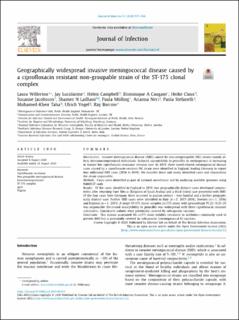| dc.contributor.author | Willerton, Laura | |
| dc.contributor.author | Lucidarme, Jay | |
| dc.contributor.author | Campbell, Helen | |
| dc.contributor.author | Caugant, Dominique A | |
| dc.contributor.author | Claus, Heike | |
| dc.contributor.author | Jacobsson, Susanne | |
| dc.contributor.author | Ladhani, Shamez N. | |
| dc.contributor.author | Mölling, Paula | |
| dc.contributor.author | Stefanelli, Paola | |
| dc.contributor.author | Taha, Muhamed-Kheir | |
| dc.contributor.author | Vogel, Ulrich | |
| dc.contributor.author | Borrow, Ray | |
| dc.date.accessioned | 2020-12-16T10:34:31Z | |
| dc.date.available | 2020-12-16T10:34:31Z | |
| dc.date.created | 2020-12-15T13:53:27Z | |
| dc.date.issued | 2020 | |
| dc.identifier.citation | Journal of Infection. 2020, 81 (2020), 575-584. | |
| dc.identifier.issn | 0163-4453 | |
| dc.identifier.uri | https://hdl.handle.net/11250/2719772 | |
| dc.description.abstract | s u m m a r y Introduction: Invasive meningococcal disease (IMD) caused by non-serogroupable (NG) strains mainly affects immunocompromised individuals. Reduced susceptibility to penicillin in meningococci is increasing in Europe but ciprofloxacin resistance remains rare. In 2019, three travel-related meningococcal disease cases caused by a ciprofloxacin-resistant NG strain were identified in England, leading Germany to report four additional IMD cases (2016 to 2019). We describe these and newly identified cases and characterise the strain responsible. Methods: Cases were identified as part of national surveillance and by analysing available genomes using PubMLST tools. Results: Of the cases identified in England in 2019, two geographically distinct cases developed conjunctivitis after returning from Mecca (Kingdom of Saudi Arabia) and a third linked case presented with IMD. Of the four cases from Germany, three occurred in asylum seekers – two familial and a further geographically distinct case. Further IMD cases were identified in Italy (n = 2; 2017–2018), Sweden (n = 1; 2016) and England (n = 1; 2015). A single ST-175 clonal complex (cc175) strain with genosubtype P1.22–11,15–25 was responsible. Decreased susceptibility to penicillin was widespread with three ciprofloxacin resistant subclusters. Constituent isolates were potentially covered by subcapsular vaccines. Conclusion: This disease associated NG cc175 strain exhibits resistance to antibiotics commonly used to prevent IMD but is potentially covered by subcapsular (meningococcal B) vaccines. Crown Copyright © 2020 Published by Elsevier Ltd on behalf of The British Infection Association. This is an open access article under the Open Government License (OGL) (http://www.nationalarchives.gov.uk/doc/open-government-licence/version/3/) | |
| dc.language.iso | nob | |
| dc.title | Geographically widespread invasive meningococcal disease caused by a ciprofloxacin resistant non-groupable strain of the ST-175 clonal complex | |
| dc.type | Peer reviewed | |
| dc.type | Journal article | |
| dc.description.version | publishedVersion | |
| dc.source.pagenumber | 575-584 | |
| dc.source.volume | 81 | |
| dc.source.journal | Journal of Infection | |
| dc.source.issue | 2020 | |
| dc.identifier.doi | 10.1016/j.jinf.2020.08.030 | |
| dc.identifier.cristin | 1860075 | |
| cristin.ispublished | true | |
| cristin.fulltext | original | |
| cristin.qualitycode | 1 | |
